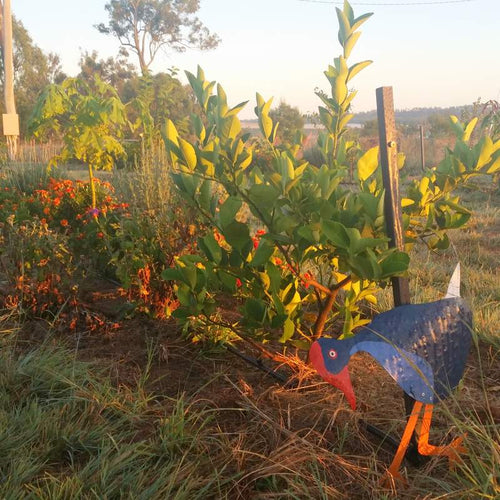What you need to know about soil
What is soil anyway?
Soil is the mixture of ground-up rock and decaying plants and insects that support a myriad of life from earthworms and plants that you can see down to the teeny tiny microbes that you can’t see, but are just as important.
Soil texture
The texture of your soil is really just the size of the ground-up rock. The largest size is sand (0.2-0.02 mm), followed by silt (0.02-0.002 mm) and finally the smallest is clay (less than 0.002 mm). I often hear people say that they have “clay soil” when its hard to dig, but that really comes down to the next topic, soil structure. The best way to test your soil texture is what I call the sausage test (officially the “ball and ribbon test”). Try to roll some moist soil into a little ball between your hands and then into a sausage. If you can’t even get it to roll into a ball, you have sand. If you can get a nice smooth, long sausage, then you have clay. Anything in between, is a mixture of sand, silt and clay. If you rub the soil between your fingers and you can fell the grains, there is sand in your soil. We have a range of soils over our property, but most are clay loams (a loam is a mixture of all three textures), we always come back from walks around the paddocks with dirty hands from our sausage tests.
Soil structure
Even if you don’t have clay, you can have tight soils that you cannot dig. This is caused by poor soil structure. Soil structure is the size of the “aggregate” or the clumps of the particles of sand, silt and clay (and organic matter). Ideally you want durable aggregates around the size of peas. If you have soil that is either dust or “massive” (i.e. undiggable), then you have some work to do. I have seen some soil tests where you start by digging out a clump of soil a spade width square and observe the soil. This is simply not possible in the soil in our property at the moment due to poor structure. You are lucky to get a spade in 1 inch if you jump on it! However, in my garden I have some nice aggregates.
Soil chemistry
Soil structure depends on soil chemistry, soil biology (see next topic) and moisture content. Soil chemistry is a huge topic , and I think its worth revisiting the key points here. To understand your soil chemistry, you really need to send a sample to be tested, this is not a huge expense, and you might be able to get it done even cheaper through your agronomist, local council or extension service. The test results will tell you three important things about your soil and you can probably ignore the rest (unless you have animals, and then you want to check that they are getting enough trace minerals like copper and selenium).
1. Soil pH, ideally this should be 7, if its too high or too low, you probably have other issues, keep reading...
2. Cation exchange capacity (CEC), this is the capacity of the soil to hold onto nutrients, if you have high clay soil or high organic matter, you will have high CEC and therefore, “fertile” soil. Your report should give you the ratio between the most common cations, sodium, potassium, calcium, magnesium and hydrogen. This is also related to pH (low pH occurs when hydrogen ion concentration is high). Ideally you want around about 65% Calcium, 15% Magnesium, 4% Potassium, and 1% to 5% Sodium. Too much magnesium results in a tighter clay (because they are smaller atoms). Too much sodium results in a loose “sodic” soil that is prone to erosion because the sodium doesn't hold the clay together. You can correct the CEC by adding lime for calcium (and pH increase) or dolomite for calcium/magnesium, or gypsum for calcium without a pH change. This will displace the hydrogen and sodium, which are only held weakly.
3. Organic matter, most problems with your soil can be corrected with sufficient organic matter. Organic matter increases the amount of nutrients that the soil can hold, corrects pH, improves the water holding capacity, and most importantly, feeds the soil life in the next topic. Increase organic matter using compost, mulch, and most importantly, cover crops because plants increase organic matter through their roots. If you have no plants growing you are losing organic matter through oxidation (reaction with oxygen) and degrading your soil (notwithstanding if your soil is covered in snow, then it is all dormant and its ok to have nothing growing).
Soil life
Your soil is full of life, one teaspoon of soil contains more microbes than there are people on earth.
That’s one teaspoon of healthy soil, soil that hasn’t been poisoned by chemicals like herbicides, pesticides or artificial fertilisers. Microbes are responsible for improving soil structure by producing sticky chemicals, they also dissolves minerals and make nutrients available to plants (for example, potassium solubilisation) and they increase the organic matter in your soil by changing liable humus to fixed or permanent humus. You need to adopt gardening (and farming) practices that encourage soil life because it will ultimately reduce the work that you need to do. Everything that builds organic matter, also feeds microbes, just try to avoid chemicals and encourage a healthy ecosystem through companion planting and beneficial insects.
There is obviously more to soil than I can cover in this post, but I hope that this gets you started and helps you understand how its all connected. No matter what texture or chemistry you start with, the key is increasing organic matter and soil life.























Leave a comment